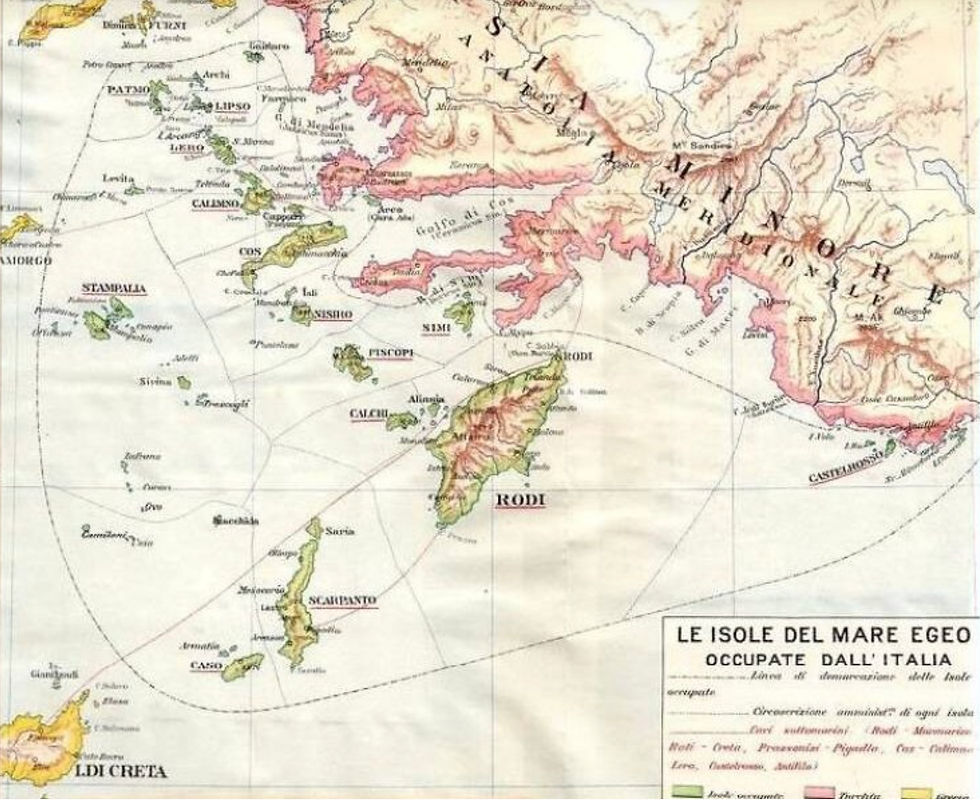If the northerly Meltemi is too strong in our third week of sailing, we continue further south to the Greek island of Leros before turning west. A surprise is waiting in the Bay of Lakki - an Italian Art Deco town. It feels like being in Rome’s Cine Città. But we are in Greece. There is only one other place with similar buildings. In Messina in Sticily.

Lakki is the Greek name for Portolago, Italy’s main naval base in the Dodecanes for 40 years. It became Italian in 1912 during the war with Turkey. Italy’s Navy, the Regia Marina, captured the Dodecanes Islands to cut the Turkish supply lines to North Africa. The deep bay of Lakki was immediately recognized for its potential as naval base.

Italian Troops landing in 1912 on Rhodes
But it took some years for the idea to hatch. Italy had agreed to return the Dodecanes to Greece by 1922 but after Greece lost the war with Turkey, Mussolini reneged on the promise. The islands stayed Italian. Italianization of the Dodecanes followed quickly. Italian was established as second language. Many Greek people older than 90 years still speak it – albeit reluctantly. Higher education was only possible in Italy. The Catholic church was re-established. When you walk through the quarters of the Knights of St John in Rhodes you may wonder who paid for their beautiful restauration. It was Mussolini.

The Dodecanese Islands became permanently Italian with the Treaty of Lausanne 1923
The fascist dictator had big ideas for Italy. One of them was his fixation on re-creating the Mare Nostrum, the Mediterranean under Italian control. He claimed large parts of the Dalmatian coast, the western part of Albania, briefly occupied Corfu, lusted after the French colonies of Tunisia and Algeria, claimed Corsica and the French part of Savoy and worked hard to get Franco into a permanent alliance. None of this worked, not even his plans to take Franco under his wings despite Mussolini’s massive intervention in the Spanish Civil War. European politician did not take his talk seriously. They considered it to be fascist rabble-rousing. But Mussolini was serious. In April 1939, he invaded and occupied Albania. After Germany defeated France in May 1940, he took French Savoy and in October 1940 attacked Greece. Reminds me of Putin’s visions of Russia which nobody took seriously.

Mussolini got closest to his dreams in 1943 when Italy "controlled" a large Part of the Mare Nostrum (area within the green line) - albeit as Junior Partner of Nazi Germany
In the context of his aggressive foreign policy, Mussolini needed a secure Naval base for operations towards English Cyprus and Alexandria in Egypt, the harbor for the Royal Navy’s Mediterranean Fleet. Portolago was ideal. The bay was 3.5 km long, 1 km wide with a narrow entrance and deep enough for all modern warships.

Sea Planes of the Regia Marina in Portolago - They were used for long-distance Reco
Lakki Bay was the home port for 2 Italian destroyers, 2 torpedo boats, 4 submarines and a wing of reconnaissance seaplanes. The hills surrounding the bay were fortified with heavy naval gun batteries. Also, large oil storage facilities were built to support any sortie of the Regia Marina. At the peak, 7’000 military personnel were stationed here.

Photo of Italy's Naval Base in Porto Lago, taken by the Royal Air Force during WWII
Of course, 7'000 soldiers did not come alone. NCOs and Officers in the Regia Marina were professional military personnel with families and children. The Art Deco town was built for them. A large swampy area next to the beach was drained to make it possible.

Portolago in 1937
Two young Italian architects, Rodolfo Petracco and Armando Bernabiti were asked to design and build the town. Far away from Italy, they could deviate from Mussolini’s pompous style which we are familiar with from the Central Station in Milan. Petracco and Bernabiti built a spacious town with wide boulevard, a cinema-hotel complex, an impressive food hall, a clock tower, a modern primary school and several villas with apartments for the officers.

Armando Bernardini Rodolfo Petracco

Food Market with Clock Tower

Cinema and the former "Albergo Romano"
Many of them are nicely preserved or restored despite the heavy fighting in 1943. When Italy surrendered in September 1943, an English Task Force tried to take the Dodecanese. But the Wehrmacht would have none of it. The Dodecanese was too close to the strategically important oilfields in Romania. After 52 days of heavy fighting which inspired the book and movie “The Guns of Navarone”, the Germans took the islands back. Leros was the last to fall. An English and a Free Greek destroyer now rest at the bottom of the Bay of Lakki.

The British Destroyer Intrepid and the Greek Destroyer Queen Olga were sunk on 27-9-1943
Leros was returned to Greece in 1948 with all the other Dodecanese Islands. There was no need for a large naval base there any longer. Many buildings were converted. Some became schools. Most served as prisons to intern the communist DSA fighters. The most notorious was the technical school which was used for mentally ill patients who were left there to waste away with no treatment. Many of them were actually opposition leaders declared mentally ill by war tribunals. Luckily, all this ended with the fall of Greece’s military dictators in 1974. Leros is now a wonderful Greek island off the beaten track with wonderful wreck diving opportunities and great trekking up the mountains where the Knights of St John built their strong holds.
For People who love a video:
Comments